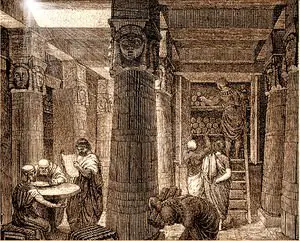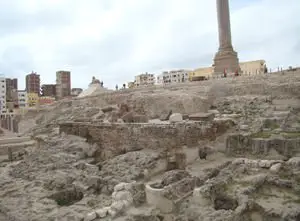How was the Library of Alexandria Destroyed
The Library of Alexandria is one of the most famous and well-known buildings in the ancient world. Despite this fame, scholars know little about it and much debate surrounds the details of its existence and eventual destruction. Most disagree on its size, its location, and most of all, how it was ultimately destroyed.[1]
Although the Library of Alexandria was not the first library of its kind in the ancient world, if what its contemporaries say about it is true, it was most certainly the largest. Many libraries existed in antiquity, but none contained as many books or enjoyed the same amount of financial support from the ruling monarchy. The Library of Alexandria was utilized by some of the most famous scholars of its time, and it amassed a collection of books. Some say it was half a million or more. No other institution had such a reputation. Ultimately the library was destroyed, but scholars do not know how or even in what century it met its demise. Although the Library is one of the most famous relics of the ancient world, we know very little about its appearance, the work is done there, or how it eventually came to its end.
Ancient Learning and Libraries
With the invention of writing, believed to have occurred in Mesopotamia around 3200 B.C., came the need to archive and store collections of texts. Most of the earliest clay tablets that were created contained information saved for practical purposes. When their relevance expired, the tablets were either erased and used again or reused as building materials. Their creators did not need to save or archive them, and as such, those first examples of writing are lost.
The earliest known collection of archived content comes from the ancient Sumerian city of Uruk, located in the southeast of Iraq. Archaeologists discovered roughly 4500 texts as part of a collection of varying topics from astronomy to mathematics. This is the earliest known evidence of what archaeologists call “archival behavior.” Other libraries that existed in that time included The Royal Library of Antioch (est. 221 B.C.) and the already ancient Library of Ashurbanipal, located in modern-day Iraq. It is said that, upon seeing Ashurbanipal, Alexander the Great was inspired to establish his own Library, and he bestowed that responsibility upon his Macedonian general Ptolemy I. [2]
Outline of the Museum and the Library
The Library and Museum were founded sometime between 300 and 290 BC. Scholars are unclear who founded it, but most agree it was either the first or the second King from the Ptolemaic dynasty. The Ptolemies were a dynasty of Pharaohs who ruled Egypt for nearly 300 years. The first Ptolemy was a general under Alexander the Great. They financially supported the library and its scholars and earned a reputation in the ancient world for being culturally enlightened rulers.[3]
The Library of Alexandria contained both a library and a museum. The museum was made of a community of scholars who were involved in academic and religious pursuits. The museum was named for the Muses, the Greek goddesses of artistry and scholarship. Its resident scholars studied mathematics, medicine, astronomy, and literature. They are famous for having edited most major Greek texts, including those of Homer and Hesiod. It is also believed that the library scholars served as teachers for privileged members of the community.[4] The library also had gardens, decorated walkways, and a dining hall where all of the museum's fellows ate together [5]
It is not known how many members the museum had. Their names have been lost to history. [6] However, it is known that many famous intellectuals studied and worked there, including Euclid, Callimachus, and Eratosthenes. [7] The scholars were led by a librarian who was appointed by the King. The librarian was the head scholar, head scholar, and tutor to the royal family. [8]
The librarians and the Ptolemies alike went to great lengths to obtain as many books as possible. Scholars were sent to other major cities such as Athens and Rhodes, to buy books. All ships that docked in the harbor were searched, and the books were taken and copied. The copies (not the originals) were returned to the owners. Books known to have been acquired this way include the tragedies of Sophocles, Aeschylus, and Euripides.[9] It is believed that the Library may have contained as many as half a million scrolls. If these estimates are accurate, the Library of Alexandria was significantly larger than any other library of its time.
The Library Destroyed
It is unknown when or how the library was destroyed as there are no primary sources that discuss its destruction. Scholars can’t even be sure about a century when it may have occurred. Some scholars believe it was destroyed as early as 48 A.D. while others place the date six hundred years later in 641. It is not known where the library was located within the city nor how large it was, how many buildings it contained, or how many scholars lived there. There are no eyewitness accounts or even primary sources which mention the destruction of the library.[10]
It is most widely believed that the Library of Alexandria was destroyed in a fire that was started when Caesar burned the Egyptian fleet during the Alexandrian Warn in 48 B.C.[11] Instead, Many Islamic scholars believe that Umar's order burned the library, a powerful 7th century Caliph from Mecca, after the Muslim conquest of Alexandria 641 A.D. Others believe that Emperor Theodosius burned it in 390 A.D. Finally, many believe it was destroyed during the recapture of Alexandria by Aurelian during the revolt of Queen Zenobia of Palmyra in 269 A.D.
Despite the best efforts of classical scholars, most details about the Library of Alexandria remain a mystery. What is known is that the Library was an unparalleled center of learning in the ancient world, which enjoyed the patronage of the ruling monarchy for centuries. Scholars traveled from all over the world to study at Alexandria and copy their books, and it has entered our modern psyche as a symbol of a great loss of knowledge and culture. As time goes on, scholars and the general public alike hope to eventually shed light on the mystery of its holdings and its eventual destruction. Until then, the details of the events in the Library of Alexandria's life are left to our imagination.
References
- Jump up ↑ Galbraith, James. (2008). What Happened To The Ancient Library Of Alexandria?. College & Research Libraries, 69(6), 590 - 592. UC Irvine: UC Irvine Libraries. Web. 6 Dec, 2015.
- Jump up ↑ Philips, Heather A., “The Great Library of Alexandria?” Library Philosophy and Practice:1 August, 2010. Web. 10 January, 2016.
- Jump up ↑ Thiem, Jon. “The Great Library of Alexandria Burnt: Towards the History of a Symbol.” Journal of the History of Ideas 40.4 (1979):507. Web. 6 Dec, 2015,
- Jump up ↑ Erskine, Andrew. “Culture and Power in Ptolemaic Egypt: The Museum and Library of Alexandria.” Greece & Rome 42.1 (1995): 38. Web. 6 Dec 2015 38
- Jump up ↑ Hendrickson, Thomas. “The Invention Of The Greek Library.” Transactions Of The American Philological Association 144.2 (2014): 371-413. MLA International Bibliography. Web. 6 Dec. 2015.
- Jump up ↑ Erskine, 39.
- Jump up ↑ Erskine, 38
- Jump up ↑ Erskine, 39
- Jump up ↑ Erskine, 38
- Jump up ↑ Erskine, 38
- Jump up ↑ Thiem

